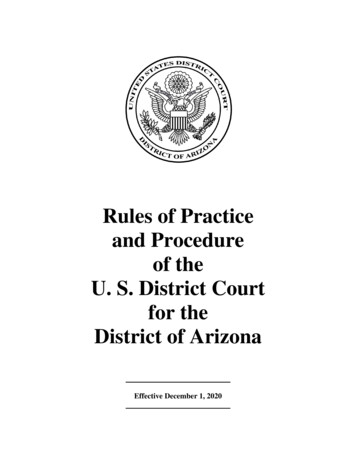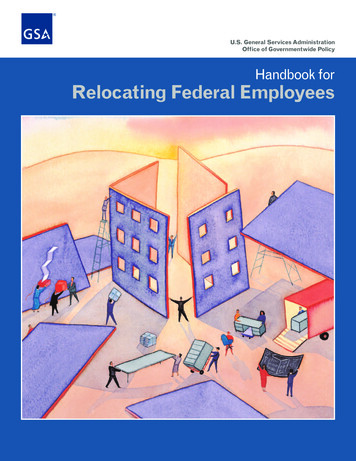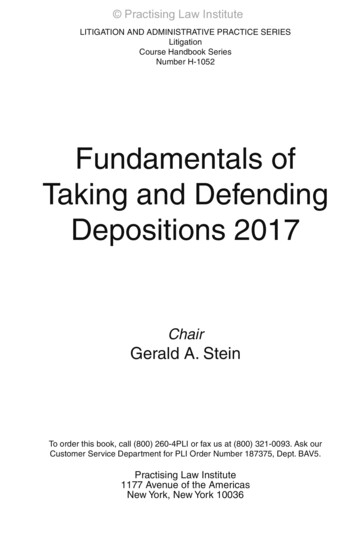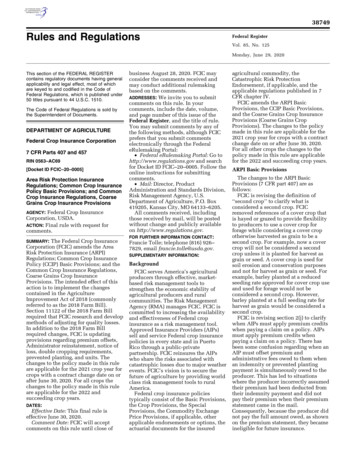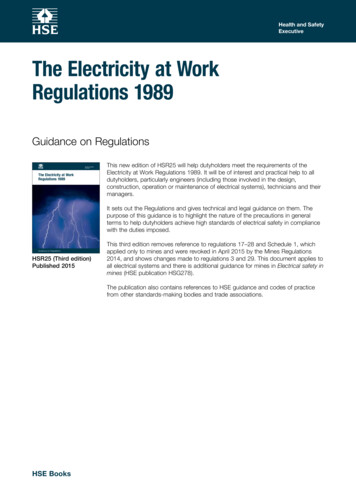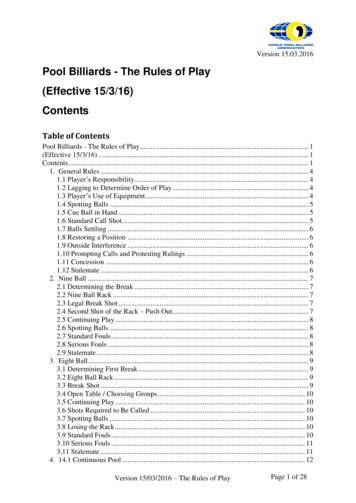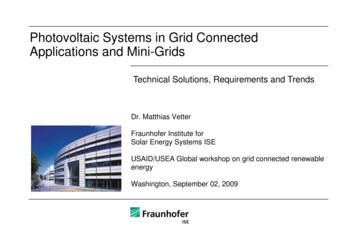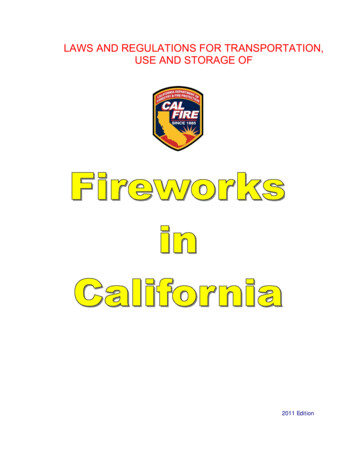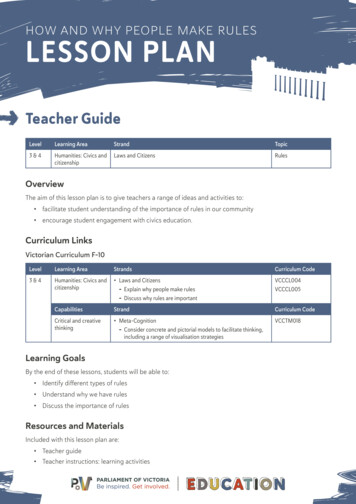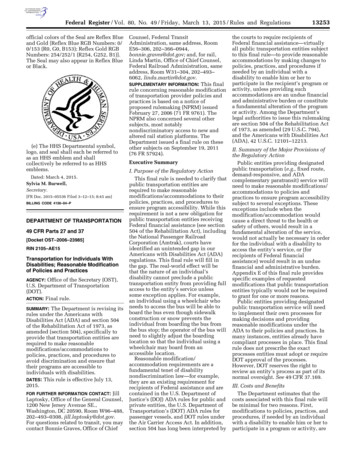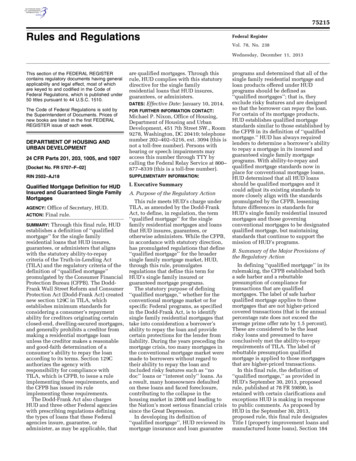
Transcription
75215Rules and RegulationsFederal RegisterVol. 78, No. 238Wednesday, December 11, 2013This section of the FEDERAL REGISTERcontains regulatory documents having generalapplicability and legal effect, most of whichare keyed to and codified in the Code ofFederal Regulations, which is published under50 titles pursuant to 44 U.S.C. 1510.The Code of Federal Regulations is sold bythe Superintendent of Documents. Prices ofnew books are listed in the first FEDERALREGISTER issue of each week.DEPARTMENT OF HOUSING ANDURBAN DEVELOPMENT24 CFR Parts 201, 203, 1005, and 1007[Docket No. FR 5707–F–02]RIN 2502–AJ18Qualified Mortgage Definition for HUDInsured and Guaranteed Single FamilyMortgagesOffice of Secretary, HUD.ACTION: Final rule.AGENCY:Through this final rule, HUDestablishes a definition of ‘‘qualifiedmortgage’’ for the single familyresidential loans that HUD insures,guarantees, or administers that alignswith the statutory ability-to-repaycriteria of the Truth-in-Lending Act(TILA) and the regulatory criteria of thedefinition of ‘‘qualified mortgage’’promulgated by the Consumer FinancialProtection Bureau (CFPB). The DoddFrank Wall Street Reform and ConsumerProtection Act (Dodd-Frank Act) creatednew section 129C in TILA, whichestablishes minimum standards forconsidering a consumer’s repaymentability for creditors originating certainclosed-end, dwelling-secured mortgages,and generally prohibits a creditor frommaking a residential mortgage loanunless the creditor makes a reasonableand good-faith determination of aconsumer’s ability to repay the loanaccording to its terms. Section 129Cauthorizes the agency withresponsibility for compliance withTILA, which is CFPB, to issue a ruleimplementing these requirements, andthe CFPB has issued its ruleimplementing these requirements.The Dodd-Frank Act also chargesHUD and three other Federal agencieswith prescribing regulations definingthe types of loans that these Federalagencies insure, guarantee, oradminister, as may be applicable, thatrmajette on DSK2TPTVN1PROD with RULESSUMMARY:VerDate Mar 15 201014:26 Dec 10, 2013Jkt 232001are qualified mortgages. Through thisrule, HUD complies with this statutorydirective for the single familyresidential loans that HUD insures,guarantees, or administers.DATES: Effective Date: January 10, 2014.FOR FURTHER INFORMATION CONTACT:Michael P. Nixon, Office of Housing,Department of Housing and UrbanDevelopment, 451 7th Street SW., Room9278, Washington, DC 20410; telephonenumber 202–402–5216, ext. 3094 (this isnot a toll-free number). Persons withhearing or speech impairments mayaccess this number through TTY bycalling the Federal Relay Service at 800–877–8339 (this is a toll-free number).SUPPLEMENTARY INFORMATION:I. Executive SummaryA. Purpose of the Regulatory ActionThis rule meets HUD’s charge underTILA, as amended by the Dodd-FrankAct, to define, in regulation, the term‘‘qualified mortgage’’ for the singlefamily residential mortgages and loansthat HUD insures, guarantees, orotherwise administers. While the CFPB,in accordance with statutory direction,has promulgated regulations that define‘‘qualified mortgage’’ for the broadersingle family mortgage market, HUD,through this rule, promulgatesregulations that define this term forHUD’s single family insured orguaranteed mortgage programs.The statutory purpose of defining‘‘qualified mortgage,’’ whether for theconventional mortgage market or forspecific Federal programs, as specifiedin the Dodd-Frank Act, is to identifysingle family residential mortgages thattake into consideration a borrower’sability to repay the loan and providecertain protections for the lender fromliability. During the years preceding themortgage crisis, too many mortgages inthe conventional mortgage market weremade to borrowers without regard totheir ability to repay the loan andincluded risky features such as ‘‘nodoc’’ loans or ‘‘interest only’’ loans. Asa result, many homeowners defaultedon these loans and faced foreclosure,contributing to the collapse in thehousing market in 2008 and leading tothe Nation’s most serious financial crisissince the Great Depression.In developing its definition of‘‘qualified mortgage’’, HUD reviewed itsmortgage insurance and loan guaranteePO 00000Frm 00001Fmt 4700Sfmt 4700programs and determined that all of thesingle family residential mortgage andloan products offered under HUDprograms should be defined as‘‘qualified mortgages’’; that is, theyexclude risky features and are designedso that the borrower can repay the loan.For certain of its mortgage products,HUD establishes qualified mortgagestandards similar to those established bythe CFPB in its definition of ‘‘qualifiedmortgage.’’ HUD has always requiredlenders to determine a borrower’s abilityto repay a mortgage in its insured andguaranteed single family mortgageprograms. With ability-to-repay andqualified mortgage standards now inplace for conventional mortgage loans,HUD determined that all HUD loansshould be qualified mortgages and itcould adjust its existing standards tomore closely align with the standardspromulgated by the CFPB, lesseningfuture differences in standards forHUD’s single family residential insuredmortgages and those governingconventional mortgages to be designatedqualified mortgage, but maintainingstandards that continue to support themission of HUD’s programs.B. Summary of the Major Provisions ofthe Regulatory ActionIn defining ‘‘qualified mortgage’’ in itsrulemaking, the CFPB established botha safe harbor and a rebuttablepresumption of compliance fortransactions that are qualifiedmortgages. The label of safe harborqualified mortgage applies to thosemortgages that are not higher-pricedcovered transactions (that is the annualpercentage rate does not exceed theaverage prime offer rate by 1.5 percent).These are considered to be the leastrisky loans and presumed to haveconclusively met the ability-to-repayrequirements of TILA. The label ofrebuttable presumption qualifiedmortgage is applied to those mortgagesthat are higher-priced transactions.In this final rule, the definition of‘‘qualified mortgage,’’ as provided inHUD’s September 30, 2013, proposedrule, published at 78 FR 59890, isretained with certain clarifications andexceptions HUD is making in responseto public comments. As proposed byHUD in the September 30, 2013,proposed rule, this final rule designatesTitle I (property improvement loans andmanufactured home loans), Section 184E:\FR\FM\11DER1.SGM11DER1
75216Federal Register / Vol. 78, No. 238 / Wednesday, December 11, 2013 / Rules and Regulationsrmajette on DSK2TPTVN1PROD with RULES(Indian housing loans), and Section184A (Native Hawaiian housing loans)insured mortgages and guaranteed loanscovered by this rule as safe harborqualified mortgages and no changes tothe current underwriting requirementsof these mortgage and loan products aremade by this final rule. To this list, FHAadds manufactured housing insuredunder Title II of the National HousingAct (Title II) and clarifies that the TitleI Manufactured Home Loan program isincluded in the Title I exemption.However, for its largest volume ofmortgage products, those insured underTitle II of the National Housing Act,with certain exceptions, HUD retainsthe two categories of qualifiedmortgages similar to the two categoriescreated in the CFPB final rule—a safeharbor qualified mortgage and arebuttable presumption qualifiedmortgage. HUD continues to exemptreverse mortgages insured under section255 of Title II from the ‘‘qualifiedmortgage’’ definition. HUD has alsoadded to the list of exemptedtransactions Title II insured mortgagesmade by housing finance agencies andcertain other governmental or nonprofitorganizations providing home financingunder programs designed for low- andmoderate-income individuals andfamilies, and discussed in more detaillater in this preamble.For the remaining Title II insuredmortgages, this final rule, consistentwith the proposed rule, defines safeharbor qualified mortgage as a mortgageinsured under Title II of the NationalHousing Act that meets the points andfees limit adopted by the CFPB in itsregulation at 12 CFR 1026.43(e)(3), andthat has an annual percentage rate for afirst-lien mortgage relative to theaverage prime offer rate that is no morethan the sum of the annual mortgageinsurance premium and 1.15 percentagepoints. This final rule defines arebuttable presumption qualifiedmortgage as a single family mortgageinsured under Title II of the NationalHousing Act that meets the points andfees limit adopted by the CFPB in itsregulation at 12 CFR 1026.43(e)(3), buthas an annual percentage rate thatexceeds the average prime offer rate fora comparable mortgage, as of the datethe interest rate is set, by more than thesum of the annual mortgage insuranceVerDate Mar 15 201014:26 Dec 10, 2013Jkt 232001premium and 1.15 percentage points fora first-lien mortgage.HUD requires that all loans, subject tothe exceptions noted, be insured underTitle II of the National Housing Act andmeet the CFPB’s points and fees limit at12 CFR 1026.43(e)(3) in order to beeither a rebuttable presumption or safeharbor qualified mortgage. The CFPB seta three percent points and fees limit forits definition of qualified mortgage andallowed for adjustments of this limit tofacilitate the presumption of compliancefor smaller loans.As more fully discussed in HUD’sSeptember 30, 2013, proposed rule,HUD establishes two categories ofqualified mortgages for the majority ofNational Housing Act mortgages tomaintain consistency with the TILAstatutory criteria defining qualifiedmortgage, as well as the CFPB’sdefinition, to the extent consistent withthe National Housing Act.While the final rule makes nosignificant changes to HUD’s proposedcore definition of qualified mortgage, asnoted above, HUD is making certainclarifications and exceptions.For example, commenters stated thatcompliance with HUD regulationswould necessitate further andimmediate system changes and that thelending industry lacked sufficient timeto make such changes by January 2014.HUD clarifies that HUD’s definition ofsafe harbor qualified mortgageincorporates CFPB’s requirements for asafe harbor qualified mortgage under thespecial provision for loans insuredunder the National Housing Act whileallowing for a higher APR threshold, socompliance with HUD regulations doesnot necessitate immediate industrychanges for lenders to identify safeharbor qualified mortgages under HUD’sdefinition by January 2014. In otherwords, compared to the CFPB’sregulations, this rule allows more FHAmortgages to qualify as safe harborqualified mortgages; every FHA loanthat would have qualified as a safeharbor qualified mortgage under theCFPB regulations for loans insuredunder the National Housing Act wouldqualify as a safe harbor qualifiedmortgage under this HUD rule. Since thelending industry must comply withCFPB’s regulations by January 2014, andwere given a full year to prepare forcompliance with the CFPB regulations,PO 00000Frm 00002Fmt 4700Sfmt 4700this clarification should ease concernsabout additional immediate compliancecosts and the need for additional timeto comply with HUD’s qualifiedmortgage regulations.C. Costs and BenefitsHUD’s final rule, in effect, reclassifiesa sizeable group (about 19 percent) ofTitle II loans insured under the NationalHousing Act from rebuttablepresumption qualified mortgages underthe CFPB regulations to safe harborqualified mortgages under HUD’sregulation, less than one percent wouldremain a rebuttable presumptionqualified mortgage. A small number(about 7 percent) of Title II loans wouldcontinue to not qualify as qualifiedmortgage based on their exceeding thepoints and fees limit, while theremaining FHA loans (about 74 percent)would qualify for qualified mortgagestatus with a safe harbor presumption ofcompliance with the ability to repayrequirements under both the CFPB’srule and HUD’s rule. The Title II loansthat would be non-qualified mortgagesunder the CFPB’s rule would remainnon-qualified mortgage under theproposed rule. The difference is thatHUD, through this rule, will no longerinsure loans with points and fees abovethe CFPB level for qualified mortgage,but expects that most of these loans willadapt to meet the points and fees to beinsured.In addition, HUD classifies all Title I,Title II manufactured housing andSection 184 and Section 184A insuredmortgages and guaranteed loans as safeharbor qualified mortgages that wouldhave most likely been non-qualifiedmortgages under the CFPB’s rule.Classifying these programs as safeharbor recognizes the unique nature ofthese loans. For these programs, HUDbelieves that providing safe harborstatus to these programs will notincrease market share but insteadmaintain availability of these productsto the underserved borrowers targeted,and allow HUD additional time tofurther examine these programs andwhether they should be covered by adefinition of ‘‘qualified mortgage’’similar to the definition provided in thisrule for Title II mortgages.As a result of these reclassifications,HUD expects the following economicimpacts:E:\FR\FM\11DER1.SGM11DER1
Federal Register / Vol. 78, No. 238 / Wednesday, December 11, 2013 / Rules and Regulations75217TABLE 1—SUMMARY OF ECONOMIC EFFECTS: CHANGING THE REBUTTABLE PRESUMPTION STANDARD FOR TITLE I, TITLEII, SECTION 184, AND SECTION 184A LOANSEffectDistributionBenefits:Lower legal costs through an increase in the number of safe harbor loans.Costs:Foregone benefits from ability-to-pay lawsuitsthrough incremental decrease in rebuttable presumption loans.Operational costs through the programming of anew HUD standard.Transfers:Lower interest rates for FHA mortgages due to theincreased legal benefits for lenders with the HUDrule vs. CFPB patch.Potential increase in the volume of loans due togreater legal benefits to lenders for HUD rule relative to CFPB patch.Effect sizeLenders (transfers to borrowers via lower interestrates). 12.2 to 40.7 million.Borrowers .Unquantified (the likelihood of such lawsuits has beenreduced greatly by changes in lending practicesstemming from the Dodd-Frank Act and the lawsuitsinitiated by Federal and State governments).De minimus.Lenders (potential transfersto borrowers through increased loan costs forborrowers).Lenders to Borrowers .Unquantified but will be capped by legal benefits tolenders.Borrowers to FHA .Unquantified as this theoretical increase in volume isexpected to be minimal. (The observable impact ofboth the CFPB patch and the HUD rule will be a decrease in volume relative to HUD volume of loanstoday).De minimus.Potential increase in the net present value of pre- Borrowers to FHA .mium revenues minus mortgage insurance claims.TABLE 2—SUMMARY OF ECONOMIC EFFECTS: ELIMINATING THE POINTS AND FEE LIMIT FOR TITLE I, SECTION 184,SECTION 184A, AND TITLE II MANUFACTURED HOUSING LOANS[All designated as safe harbor qualified mortgages]EffectBenefits:Maintained Homeownership benefits for underserved populations as loans continue to be made.Lower legal costs .Costs:Foregone benefits from ability-to-pay lawsuits .DistributionSizeBorrowers (Indian and Native Hawaiian borrowers,home improvement andmanufactured housingborrowers).Lenders .Positive but unquantified. Under the CFPB patch, therecould be a slight decrease in loans to these populations as lenders would be making non-QM loansthat are nevertheless guaranteed/insured by HUD.Borrowers .Transfers:Potential increase in the volume of loans through Borrowers to FHA .greater legal protection for HUD rule relative toCFPB patch.Potential increase in the net present value of pre- Borrowers to FHA .mium revenues minus mortgage insurance claims.rmajette on DSK2TPTVN1PROD with RULESII. BackgroundAs noted in the Summary of thispreamble, it is the Dodd-Frank Act thatcharges HUD and other Federal agenciesto define ‘‘qualified mortgage’’ for thesingle family residential loans that meetstatutory ability-to-repay requirements.New section 129C(a) of TILA, added bysection 1411 of subtitle B of Title XIVof the Dodd-Frank Act (Pub. L. 111–203,124 Stat. 1736, approved July 21, 2010),provides minimum standards forconsidering a consumer’s ability torepay a residential mortgage. NewVerDate Mar 15 201014:26 Dec 10, 2013Jkt 232001Positive but unquantified.Unquantified but expected to be minimal (the likelihoodof such lawsuits has been reduced greatly bychanges in lending practices stemming from theDodd-Frank Act and the lawsuits initiated by Federaland State governments).Unquantified but expected to be minimal.De minimus.section 129C(b), added by section 1412of the Dodd-Frank Act, establishes thepresumption that the ability-to-repayrequirements of section 129C(a) aresatisfied if a mortgage is a ‘‘qualifiedmortgage,’’ and authorizes, initially, theFederal Reserve Board and, ultimately,the CFPB,1 to prescribe regulations thatrevise, add to, or subtract from thecriteria in TILA that define a ‘‘qualifiedmortgage.’’1 On July 21, 2011, rulemaking authority underTILA transferred from the Federal Reserve Board tothe CFPB.PO 00000Frm 00003Fmt 4700Sfmt 4700Section 129C(b)(2)(A) definesqualified mortgage as a mortgage thatmeets the following requirements: (i)The transaction must have regularperiodic payments; (ii) the terms of themortgage must not result in a balloonpayment; (iii) the income and financialresources of the mortgagor are verifiedand documented; (iv) for a fixed rateloan, the underwriting process fullyamortizes the loan over the loan term;(v) for an adjustable rate loan, theunderwriting is based on the maximumrate permitted under the loan during theE:\FR\FM\11DER1.SGM11DER1
75218Federal Register / Vol. 78, No. 238 / Wednesday, December 11, 2013 / Rules and Regulationsrmajette on DSK2TPTVN1PROD with RULESfirst 5 years and includes a paymentschedule that fully amortizes the loanover the loan term; (vi) the transactionmust comply with any regulationsestablished by the CFPB relating toratios of total monthly debt to totalmonthly income; (vii) the total pointsand fees payable in connection with theloan must not exceed 3 percent of thetotal loan amount; and (viii) themortgage must not exceed 30 years,except in specific areas.2New section 129C(b)(3)(B)(ii) of TILA,also added by section 1412 of the DoddFrank Act, requires that HUD, theDepartment of Veterans Affairs (VA),and the Department of Agriculture(USDA) prescribe rules in consultationwith the Federal Reserve Board 3 todefine the types of loans they insure,guarantee, or administer, as the casemay be, that are ‘‘qualified mortgages,’’and revise, add to, or subtract from thestatutory criteria used to define aqualified mortgage.The CFPB published a final rule onJanuary 30, 2013, at 78 FR 6408,entitled, ‘‘Ability-to-Repay andQualified Mortgage Standards under theTruth in Lending Act (Regulation Z),’’which is referred to in this preamble asthe CFPB final rule. The CFPB final ruleimplemented section 129C(b) bydefining ‘‘qualified mortgage’’ with twodegrees of protections for creditors andassignees of a qualified mortgage. TheCFPB’s regulations implementingsection 129C(b) are codified at 12 CFRpart 1026. The CFPB regulationsestablish both a safe harbor and arebuttable presumption of compliancefor transactions that are ‘‘qualifiedmortgages.’’Under the CFPB’s regulation, aqualified mortgage falls into the safeharbor category and is conclusivelypresumed to have met the ability-to2 Section 129C also provides for a reversemortgage to be a qualified mortgage if the mortgagemeets the CFPB’s standards for a qualified mortgageexcept to the extent that reverse mortgages arestatutorily exempted altogether from the ability-torepay requirements. The CFPB’s regulations providethat the ability-to-repay requirements of section129C(a) do not apply to reverse mortgages. In thepreamble to its final rule published on January 30,2013, the CPFB states: ‘‘The Bureau notes that thefinal rule does not define a ‘qualified’ reversemortgage. As described above, TILA section129C(a)(8) excludes reverse mortgages from therepayment ability requirements. See section-bysection analysis of § 1026.43(a)(3)(i). However,TILA section 129C(b)(2)(ix) provides that the term‘qualified mortgage’ may include a ‘residentialmortgage loan’ that is ‘a reverse mortgage whichmeets the standards for a qualified mortgage, as setby the Bureau in rules that are consistent with thepurposes of this subsection.’ The Board’s proposaldid not include reverse mortgages in the definitionof a ‘qualified mortgage.’ ’’ See 78 FR 6516.3 Rulemaking authority under TILA wastransferred to the CFPB.VerDate Mar 15 201014:26 Dec 10, 2013Jkt 232001repay requirements if it is not a ‘‘higherpriced covered transaction.’’ 4 Aqualified mortgage that is a higherpriced covered transaction has only arebuttable presumption of compliancewith the ability-to-repay requirement,even though each element of the‘‘qualified mortgage’’ definition is met.See 12 CFR 1026.43(e)(1)(ii)(B). TheCFPB’s rule is intended to providegreater protection for borrowers byproviding only a rebuttable presumptionof compliance for higher-priced coveredtransactions.The preamble to HUD’s September 30,2013, proposed rule discussed theCFPB’s qualified mortgage regulationsin more detail. Members of the publicinterested in more detail about theCFPB’s regulations may refer to thepreamble of HUD’s September 30, 2013,proposed rule (see 78 FR 59892–59893)but more importantly should refer to thepreamble to the CFPB’s final rulepublished in the Federal Register onJanuary 30, 2013, at 78 FR 6409.5III. HUD’s September 30, 2013,Proposed RuleIn its September 30, 2013, proposedrule, HUD submitted for publiccomment regulations defining qualifiedmortgage for its insured and guaranteedsingle family loan programs. Thecovered programs consist of singlefamily loans insured under the NationalHousing Act (12 U.S.C. 1701 et seq.),and section 184 loans for Indianhousing under the Housing andCommunity Development Act of 1992(12 U.S.C. 1715z–13a) (Section 184guaranteed loans) and section 184Aloans for Native Hawaiian housingunder the Housing and CommunityDevelopment Act of 1992 (1715z–13b)(Section 184A guaranteed loans). Ofthese programs, the single family loansinsured under Title II of the NationalHousing Act (12 U.S.C. 1701 et seq.)(Title II) present the largest volume ofmortgages insured by HUD, throughFHA.In the September 30, 2013, proposedrule, HUD proposed to define all FHAinsured single family mortgages to bequalified mortgages, except for reverse4 A ‘‘higher-priced covered transaction’’ is atransaction that has an annual percentage rate(APR) that exceeds the average prime offer rate(APOR) for a comparable transaction as of the datethe interest rate is set by 1.5 or more percentagepoints for a first-lien covered transaction, or by 3.5or more percentage points for a subordinate-liencovered transaction.5 Various provisions of CFPB’s January 2013, finalrule were amended by rules published in theFederal Register on June 13, 2013, at 78 FR 35430,July 24, 2013, at 78 FR 44686, July 30, 2013, at 78FR 45842, October 1, 2013, at 78 FR 60382, andOctober 23, 2013, at 78 FR 62993.PO 00000Frm 00004Fmt 4700Sfmt 4700mortgages insured under HUD’s HomeEquity Conversion Mortgage (HECM)program (section 255 of the NationalHousing Act (12 U.S.C. 1715z–20)),which are exempt from the ability-torepay requirements. Mortgages insuredunder the Title I Property ImprovementLoan Insurance program andManufactured Home Loan program(Title I), authorized by section 2 of theNational Housing Act (12 U.S.C. 1703),and Section 184 guaranteed loans andSection 184A guaranteed loans, wouldbe designated safe harbor qualifiedmortgages, with no specific points andfees limits and with no annualpercentage rate (APR) limits. See 78 FR59895 and 59897.Similar to the CFPB’s regulations,HUD proposed to provide for two typesof qualified mortgages for FHA Title IImortgages: (1) A safe harbor qualifiedmortgage and (2) a rebuttablepresumption qualified mortgage. For theTitle II mortgages, HUD proposed tomodify the APR limit used in the‘‘higher-priced covered transaction’’element as defined by the CFPB todistinguish between HUD’s safe harborqualified mortgages and rebuttablepresumption qualified mortgages.For Title II mortgages, HUD proposedto add a new § 203.19 to its regulationsin 24 CFR part 203 6 that would require,through the proposed definition of‘‘qualified mortgage,’’ all FHA-insuredsingle family mortgages, except forHECMs, to be ‘‘qualified mortgages.’’HUD proposed to incorporate the safeharbor and rebuttable presumptionstandards within the definition of a‘‘qualified mortgage’’ rather than createsubsets based on defining whether amortgage is a higher-priced coveredtransaction, as provided in the CFPB’sregulations. HUD also proposed to adoptthe CFPB’s points and fees limitations at12 CFR 1026.43(e)(3). HUD advised, inthe proposed rule, that it considered theadoption of the points and fees limit asestablished by statute and adopted bythe CFPB in its final rule to beappropriate.7HUD’s proposed rule defined ‘‘safeharbor qualified mortgage’’ for Title IImortgages as one that meets therequirements for insurance under theNational Housing Act, meets the CFPB’spoints and fees limit, and has an APRfor a first-lien mortgage relative to theaverage prime offer rate (APOR) that6 All single family mortgages insured by FHAunder the National Housing Act are governed byregulations in 24 CFR part 203 except for propertyimprovement and manufactured home loans underTitle I and the HECM program.7 As noted in the proposed rule, HUD’s upfrontmortgage insurance premium (UFMIP) is notincluded in the points and fees.E:\FR\FM\11DER1.SGM11DER1
rmajette on DSK2TPTVN1PROD with RULESFederal Register / Vol. 78, No. 238 / Wednesday, December 11, 2013 / Rules and Regulationsdoes not exceed the combined annualmortgage insurance premium (MIP) and1.15 percentage points. HUD’s proposeddefinition of ‘‘safe harbor qualifiedmortgage’’ for Title II mortgagesprovides a different APR relative toAPOR threshold than under the CFPB’sregulation. The APR relative to APORthreshold is higher than CFPB’s andfluctuates according to the product’sMIP. The CFPB’s construct fordetermining a higher-priced coveredtransaction captured a number of FHAloans as a result of the MIP which HUDbelieves needs to be addressed.As provided in the preamble to HUD’sproposed rule, because all FHA-insuredmortgages include a MIP that may varyfrom time to time to address HUD’sfinancial soundness responsibilities,including the MIP as an element of thethreshold that distinguishes safe harborfrom rebuttable presumption allows thethreshold to ‘‘float’’ in a manner thatallows HUD to fulfill its responsibilitiesthat would not be feasible if HUDadopted a threshold based only on theamount that APR exceeds APOR. Asnoted in the proposed rule, if a straightAPR over APOR threshold were adoptedby HUD, every time HUD would changethe MIP to ensure the financialsoundness of its insurance fund andreduce risk to the fund or to reflect amore positive market, HUD would alsohave to consider changing the thresholdAPR limit. HUD also provides for ahigher overall APR relative to APOR toremove the impact of the MIP on thedesignation of ‘‘safe harbor qualifiedmortgage’’ and ‘‘rebuttable presumptionqualified mortgage’’ definitions.In the September 30, 2013, proposedrule, HUD proposed to define a‘‘rebuttable presumption qualifiedmortgage’’ for Title II mortgages as asingle family mortgage that is insuredunder the National Housing Act, doesnot exceed the CFPB’s limits on pointsand fees, and has an APR that exceedsthe APOR for a comparable mortgage, asof the date the interest rate is set, bymore than the combined annual MIPand 1.15 percentage points for a firstlien mortgage. HUD’s proposed ruleprovided that a mortgage that meets therequirements for a rebuttablepresumption qualified mortgage wouldbe presumed to comply with the abilityto repay requirements in 15 U.S.C.1639c(a). The proposed rule furtherprovided that any rebuttal of suchpresumption of compliance must showthat despite meeting the ‘‘rebuttablepresumption qualified mortgage’’requirements, the mortgagee did notmake a reasonable and good-faithdetermination of the mortgagor’srepayment ability at the time ofVerDate Mar 15 201014:26 Dec 10, 2013Jkt 232001consummation when underwriting themortgage in accordance with HUDrequirements.In the September 30, 2013, proposedrule, HUD proposed to require FHAstreamlined refinances to comply withHUD’s qualified mortgage rule; that is,to require streamlined refinances tomeet the points and fees requirements.Section 129C(a)(5) of TILA grants HUDthe authority to exempt streamlinedrefinancing from the income verificationrequirements of section 129C(a)(4),subject to certain conditions. In theproposed rule, HUD advised that it didnot consider it necessary to exercise thisauthority because HUD’s qualifiedmortgage definition results in anexemption similar to the onecontemplated under section 129C(a)(5).HUD requirements only exempt lendersfrom verifying income if the loan isoriginated consistent with the FHAstreamlined refinancing requirements,which means that the mortgage must becurrent, the loan is designed to lowerthe monthly principal and interestpayment, and the loan involves no cashback to the borrower except for minoradjustments.8HUD’s proposed rule provided adetailed description of the policy andfactors that HUD considered indeveloping a definition of ‘‘qualifiedmortgage’’ for the mortgages that itinsures, guarantees, or otherwiseadministers. HUD is not repeating suchdescription in the preamble to this finalrule, and refers interested parties to thepreamble of the September 30, 2013,proposed rule, for more detailedinformation about the proposed rulec
making a residential mortgage loan unless the creditor makes a reasonable and good-faith determination of a consumer's ability to repay the loan according to its terms. Section 129C authorizes the agency with responsibility for compliance with TILA, which is CFPB, to issue a rule implementing these requirements, and the CFPB has issued its rule
